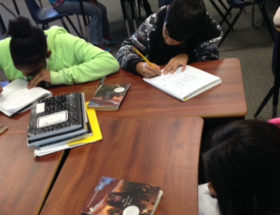 Lucy: “I’m so excited it’s Valentines Day and we have a party later.”
Lucy: “I’m so excited it’s Valentines Day and we have a party later.”
Me: “Wow, you’re dressed up for Valentines Day today with a glittery pink T-shirt and your pink fingernail polish with glitter matches your shirt!”
Lucy: “I am. My mom woke me up early this morning and she told me to come to the kitchen. She had a nail station on the table. She polished my nails and then my little sister had a turn.”
Lucy went on to share that her mom wasn’t sleeping much due to medication she was taking during her chemotherapy. Mom had been diagnosed with cancer and was juggling home responsibility, with work as a waitress and weekly trips to the hospital for treatment.
I’d worked for several months with Lucy and on more than one occasion I was frustrated with what I judged as a lack of concern on her mom’s part about Lucy’s progress in reading. It hit me that I’d been way too quick to assume lack of involvement instead of working to find out ways I could partner with Lucy’s mom to ensure her welfare at school and at home.
I remember thinking that day, “Lucy’s mom is loving and caring for her in the best way she can and with the resources she possesses. That’s worthy of my respect.”
We have to do better at connecting with families and caregivers in affirmative, healing ways in order to promote academics and social-emotional wellness for our students.
In a recent article by Jennifer Gunn:
No matter the family structure—whether students are living with two parents, single parents, extended family, foster families, or others—the adults at home play a critical role in shaping the emotional life of our students. That means that building bridges between schools, families, and communities can make a serious impact on our students’ social-emotional learning. (2018)
John Hattie reports that student-teacher relationship has an effect size of 0.52 and family involvement shows 0.5 effect size. (Effect size is a measure of how substantial a difference is: a large effect size indicates the difference is significant; smaller effect sizes indicate the difference is negligible.)
What can we can as educators do to promote academic success and social-emotional well-being for the students in our care? What steps do we take to strengthen relationships with students and their families?
Strategic Partnership
Call home in the first 6 weeks–every parent of caregiver loves to hear how their child is making progress in some area in the beginning days of school. We can never underestimate the power of forming positive relationships with families when we start by stating the assets their child brings to our learning community.
See the family unit and their own “culture” as an asset and not a liability—the unique culture and climate of each home represented in our classrooms is something to be treasured. If we, as teachers, begin our new year with the idea that we’ll be introduced to, and celebrate, differences in the families with whom we partner, we’ve tapped into a powerful dynamic.
Bring family lives into the classroom—if we’re indeed partners in developing the academic and social-emotional health of a child then we’re equally interested (and can exhibit pride) in their lives outside our learning environment. A few years ago, I visited Momentous Institute in Dallas and there were tons of photos with students and their families inside and outside every classroom. Each teacher looked like a proud parent displaying pictures of his/her beloved “kids”. Likewise, as teachers we should take the opportunity to send home lots of photos of students and their learning triumphs to be shared with families.
These three simple tasks alone would go far in developing warm, trusting, relationships grounded in the care and nurturing of students, but there’s more we can do.
Home/School Connection
Share learning moments from inside the classroom—there are several simple ways to share important academic moments from your classroom with families. This serves to celebrate, but also to inform. Every Saturday, I tutor a first-grade emerging reader and a few weeks ago I invited mom to sit in on the learning. She was wise enough to video the guided reading portion of our session. The following week when I noticed and named a smart reader move by the child, she said, “My daddy has been asking me what strategies I have to fix my problem. Just like you, he asks me if it looks right or sounds right.” That, my friends, is a true school/family partnership!
Opportunities for families/caretakers to get a close look inside the curriculum—On the campus where I coached last year, our 2nd grade team had family learning meetings to preview each of the upcoming six weeks. Parents, caretakers, siblings gathered at the end of the school day or early evening to get a detailed summary of the upcoming units in reading and math. Families had a chance to see curriculum and even experience a few learning tasks their child would encounter in the coming weeks along with specific strategy sheets for families. The best part? Families were given a survey to complete before they left that checked on their comfort level with the new information, their feedback about what would make the family meetings better and suggestions for possible “enhancements” to the six-week units.
Home visits—A lot has been written about the effectiveness of home visits. Edutopia published an article last year with valuable information and resources for teachers. “Home visits can establish positive contact and communication with families. They are not a replacement for parent-teacher conferences, but are a process through which teachers demonstrate their support for students’ families by visiting the home environment or an alternative location where the family feels at home and comfortable. Home visits should originate from a sincere desire to assist and work with families.” (Graff, 2017)
Celebrate each family culture—Every family possesses their own unique culture and that warrants celebrating. Elicit “favorites” lists from your families. Ask them to send in their top 3 list of movies, books, song lyrics or quotes. Display these in your room and let kids match family names to favorites. Invite family members to record favorite picture books, use these in your classroom listening station. Schedule times for family members/caretakers to visit the class to share a family favorite (book, vacation pics, family tradition, ethnic food, etc.).
I’ll be honest. This post had been percolating for several weeks.
My need to share comes as a result of a difficult family-school relationship some close friends recently experienced. My friends, the parents, were trying to get help from their child’s teacher and campus leaders. Phone calls were not returned, face-to-face interactions were hostile, the campus leadership spoke in disrespectful and condescending ways to the parents and it was incredibly painful to watch.
The parents were told that if they did not agree to the school’s decision, that there would not be a place for their child in the coming school year. I’m not exactly sure what was meant by that statement. Isn’t public school free and available for every child?
Needless to say, it was far from the experience we hope for all our school kids and their families.
The singular priority of a teacher, campus administrator, or educational specialist is not about personal comfort, convenience, or wielding power. An educator can and should be partners in advocating for students in a formidable partnership with the family inside and outside the classroom.
Let’s remember it’s about the kids. And forging alliances on their behalf is our privilege and our responsibility.












Focus on student strengths. Share those with the family unit. Celebrate small successes. Check in with the family goals. Sometimes survival outweighs the academics. Working towards a common goal is critical. So many important ideas here, Val.
Thanks!
Such important work we do! We need those strong partnerships.